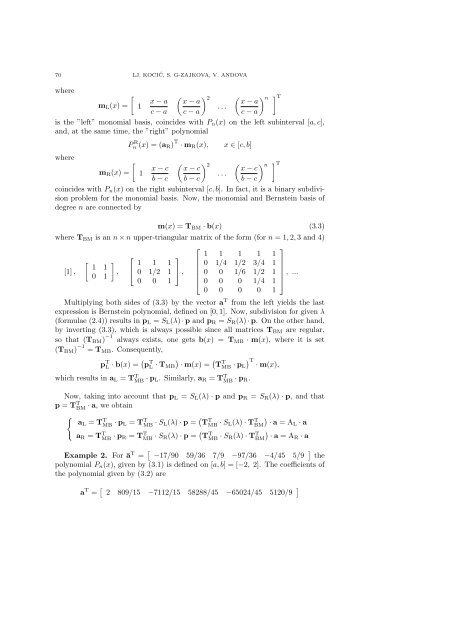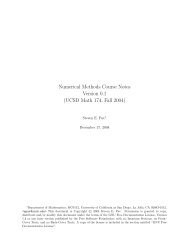Skopje, Makedonija INTERPOLATION POLYNOMIALS VIA AIFS 1 ...
Skopje, Makedonija INTERPOLATION POLYNOMIALS VIA AIFS 1 ...
Skopje, Makedonija INTERPOLATION POLYNOMIALS VIA AIFS 1 ...
Create successful ePaper yourself
Turn your PDF publications into a flip-book with our unique Google optimized e-Paper software.
70 LJ. KOCIĆ, S. G-ZAJKOVA, V. ANDOVA<br />
where<br />
[<br />
m L (x) = 1<br />
x − a<br />
c − a<br />
( ) 2 x − a<br />
...<br />
c − a<br />
( ) n<br />
] T<br />
x − a<br />
c − a<br />
is the ”left” monomial basis, coincides with P n (x) on the left subinterval [a, c],<br />
and, at the same time, the ”right” polynomial<br />
Pn R (x) =(a R ) T · m R (x), x ∈ [c, b]<br />
where<br />
[<br />
m R (x) = 1<br />
x − c<br />
b − c<br />
( ) 2 x − c<br />
...<br />
b − c<br />
( ) n<br />
] T<br />
x − c<br />
b − c<br />
coincides with P n (x) on the right subinterval [c, b]. In fact, it is a binary subdivision<br />
problem for the monomial basis. Now, the monomial and Bernstein basis of<br />
degree n are connected by<br />
m(x) =T BM · b(x) (3.3)<br />
where T BM is an n × n upper-triangular matrix of the form (for n =1, 2, 3and4)<br />
⎡<br />
⎤<br />
⎡<br />
[ ] 1 1<br />
[1] ,<br />
, ⎣ 1 1 1<br />
⎤ 1 1 1 1 1<br />
0 1/4 1/2 3/4 1<br />
0 1/2 1 ⎦ ,<br />
0 1<br />
⎢ 0 0 1/6 1/2 1<br />
⎥<br />
0 0 1 ⎣ 0 0 0 1/4 1 ⎦ , ...<br />
0 0 0 0 1<br />
Multiplying both sides of (3.3) by the vector a T from the left yields the last<br />
expression is Bernstein polynomial, defined on [0, 1]. Now, subdivision for given λ<br />
(formulae (2.4)) results in p L = S L (λ) · p and p R = S R (λ) · p. On the other hand,<br />
by inverting (3.3), which is always possible since all matrices T BM are regular,<br />
so that (T BM ) −1 always exists, one gets b(x) = T MB · m(x), where it is set<br />
(T BM ) −1 = T MB . Consequently,<br />
p T L · b(x) = ( p T ) ( )<br />
L · T MB · m(x) = T<br />
T T<br />
MB · p L · m(x),<br />
which results in a L = T T MB · p L. Similarly, a R = T T MB · p R.<br />
Now, taking into account that p L = S L (λ) · p and p R = S R (λ) · p, andthat<br />
p = T T BM · a, we obtain<br />
{<br />
aL = T T MB · p L = T T MB · S L(λ) · p = ( T T MB · S )<br />
L(λ) · T T BM · a =AL · a<br />
a R = T T MB · p R = T T MB · S R(λ) · p = ( T T MB · S R(λ) · TBM) T · a =AR · a<br />
Example 2. For ā T = [ −17/90 59/36 7/9 −97/36 −4/45 5/9 ] the<br />
polynomial P n (x), given by (3.1) is defined on [a, b] =[−2, 2]. The coefficients of<br />
the polynomial given by (3.2) are<br />
a T = [ 2 809/15 −7112/15 58288/45 −65024/45 5120/9 ]














